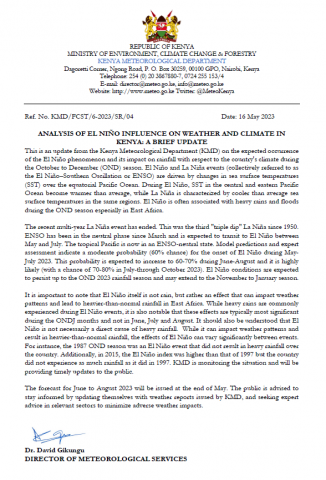
ANALYSIS OF EL NIÑO INFLUENCE ON WEATHER AND CLIMATE IN KENYA: A BRIEF UPDATE
This is an update from the Kenya Meteorological Department (KMD) on the expected occurrence of the El Niño phenomenon and its impact on rainfall with respect to the country's climate during the October to December (OND) season. El Niño and La Niña events (collectively referred to as the El Niño–Southern Oscillation or ENSO) are driven by changes in sea surface temperatures (SST) over the equatorial Pacific Ocean. During El Niño, SST in the central and eastern Pacific Ocean become warmer than average, while La Niña is characterized by cooler than average sea surface temperatures in the same regions. El Niño is often associated with heavy rains and floods during the OND season especially in East Africa.
The recent multi-year La Niña event has ended. This was the third "triple dip" La Niña since 1950. ENSO has been in the neutral phase since March and is expected to transit to El Niño between May and July. The tropical Pacific is now in an ENSO-neutral state. Model predictions and expert assessment indicate a moderate probability (60% chance) for the onset of El Niño during May- July 2023. This probability is expected to increase to 60-70% during June-August and it is highly likely (with a chance of 70-80% in July-through October 2023). El Niño conditions are expected to persist up to the OND 2023 rainfall season and may extend to the November to January season.
It is important to note that El Niño itself is not rain, but rather an effect that can impact weather patterns and lead to heavier-than-normal rainfall in East Africa. While heavy rains are commonly
experienced during El Niño events, it is also notable that these effects are typically most significant during the ONDJ months and not in June, July and August. It should also be understood that El
Niño is not necessarily a direct cause of heavy rainfall. While it can impact weather patterns and result in heavier-than-normal rainfall, the effects of El Niño can vary significantly between events.
For instance, the 1987 OND season was an El Niño event that did not result in heavy rainfall over the country. Additionally, in 2015, the El Niño index was higher than that of 1997 but the country
did not experience as much rainfall as it did in 1997. KMD is monitoring the situation and will be providing timely updates to the public.
The forecast for June to August 2023 will be issued at the end of May. The public is advised to stay informed by updating themselves with weather reports issued by KMD, and seeking expert advice in relevant sectors to minimize adverse weather impacts.
Dr. David Gikungu
DIRECTOR OF METEOROLOGICAL SERVICES
